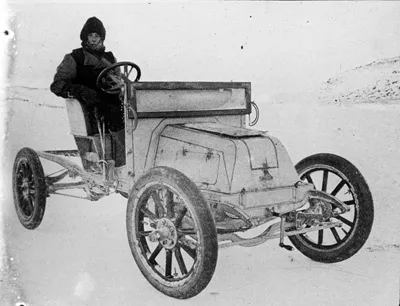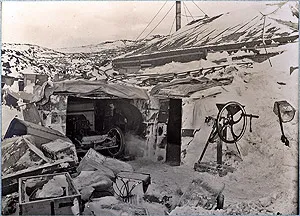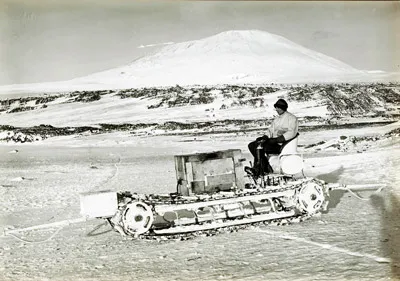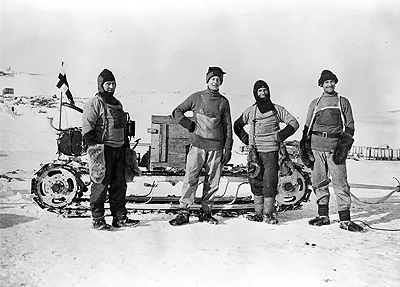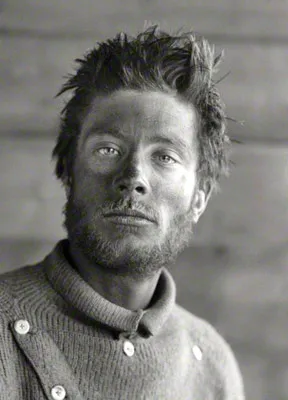
Bernard
C. Day
(1884 - 1934)
Biographical notes
Electrician / motor mechanic -
Nimrod 1907-09
Motor engineer -
Terra Nova
1910-13
Bernard Day
18th August 1884 - 1934
Born in Wymondham Leicestershire, England in 1884 and educated in Wellingborough Grammar School in Northamptonshire, he became involved in engineering in 1903 at the age of 19.
Day was working at the Arrol Johnston Car Company Ltd. in Paisley Scotland when in 1907 William Beardmore a major sponsor of Shackleton's forthcoming Antarctic expedition aboard the Nimrod donated a motor car to the expedition from the Arrol-Johnston company he had recently acquired, this was largely for publicity purposes. Day was seconded to the expedition as mechanic and driver of the car, it was the first time a car had ever been to Antarctica.
The main limitation of the car was that it had wheels and while efforts were made to place the front wheels on skis and add blocks to the rear drive wheels for extra traction, it proved of little use in snow, though worked quite well on harder surfaces and in suitable weather conditions. It successfully made several journeys of 10-16 miles (16-25km) pulling up to 1,200 lbs (544 kg) of stores and equipment loaded onto sledges.
During the winter of 1908, Day was one of four who produced the "Aurora Australis", the first book published in Antarctica.

Towing sledges with the Arrol Johnson
car in 1908
More on the first motor car in Antarctica
Day was recruited by Scott for his 1910-1913 expedition on board the Terra Nova as a motor engineer. He was now the world's only engineer with any experience of running vehicles in Antarctica. Scott took three motor sledges with him which were tracked vehicles having learned from the mistakes with Shackleton's wheeled car. They were simple and crude machines with an engine mounted between two driven axles with an exposed seat for the driver above the fuel tank. Again hopes were high and it was thought there was the possibility of driving the sledges all the way to the pole. They got off to a very inauspicious start when one of the three machines was lost through the sea-ice during unloading in Antarctica while it was driving to shore.
The other two sledges proved to be of use in hauling supplies in suitable conditions, but were not up to the rigours of Antarctica, ironically a constant problem was over-heating. They accumulated mechanical and structural damage until they reached the point where Day could no longer repair them and they were in turn abandoned.
Day's services were effectively now no longer needed and so he was sent home on the ship after the first year in 1911 during the middle summer of the two year expedition.
Once again in the winter he was involved in the production of a publication, the "South Polar Times" for which he made the covers. He was a competent amateur artist and completed some paintings on return home from notes and sketches made in Antarctica.
Day received the Polar Medal for his involvement in the two expeditions and his pioneering work with motor vehicles in Antarctica.
He saw active service in the First World War and later moved to Sydney, Australia working as an engineer, he died in Queensland Australia in 1934.
References to Bernard Day by Cherry-Garrard in "The Worst Journey in the World"
-
In the porch were the generators of the acetylene gas, which was fitted throughout by Day, who was also responsible for the fittings of the ventilator, cooking range, and stove, the chimney pipes from these running along through the middle of the hut before entering a common vent. Little heat was lost. The pipes were fitted with dampers, and air inlets which could be opened or shut at will to control the ventilation.
-
The regular sledgers in this party of officers were Scott, Wilson, Evans, Bowers, Oates (ponies), Meares (dogs), Atkinson (surgeon), Wright (physicist), Taylor (physiographer), Debenham (geologist), Gran and myself, while Day was to drive his motors as far as they would go on the Polar Journey.
-
The light which Atkinson had seen was a flare of towel soaked in petrol lit by Day at Cape Evans. He corrected his course and before long was under the rock upon which Day could be seen working like some lanky devil in one of Dante's hells.
-
"To-night the motors were to be taken on to the floe. The drifts made the road very uneven, and the first and best motor overrode its chain; the chain was replaced and the machine proceeded, but just short of the floe was thrust to a steep inclination by a ridge, and the chain again overrode the sprockets; this time by ill fortune Day slipped at the critical moment and without intention jammed the throttle full on. The engine brought up, but there was an ominous trickle of oil under the back axle, and investigation showed that the axle casing (aluminium) had split.
-
Again we got away, but did not get far before the other car began to give trouble. I went back to see what was the matter, it seems the petrol is dirty due perhaps to putting in a new drum, anyhow got her up and camped for lunch. After lunch made a move, and all seemed to be going well when Mr. Day's car gave out at the crank brasses the same as mine, so we shall have to see what is the next best thing to do. This morning before getting the car on the way had to reconstruct our loads as Mr. Day's car is finished and no more use for further service. We have got all four of us with one car now, things seems to be going fairly well, but we are still troubled with the overheating which means to say half our time is wasted. We can see dawning on us the harness before long.
-
This meant that there was trouble, and some 14 miles from Hut Point we learned that the big end of the No. 2 cylinder of Day's motor had broken, and half a mile beyond we found the motor itself, drifted up with snow, and looking a mournful wreck.
-
The man-hauling party had been waiting for six days; and, having expected us before, were getting anxious about us. They declared that they were very hungry, and Day, who was always long and thin, looked quite gaunt. Some spare biscuits which we gave them from our tent were carried off with gratitude.
-
The original intention was that Day and Hooper should return from 80° 30', but it was now decided that their unit of four should remain intact for a few days, and constitute a light man-hauling advance party to make the track.
-
We said good-bye to Day and Hooper next morning, and they set their faces northwards and homewards. Two-men parties on the Barrier are not much fun. Day had certainly done his best about the motors and they had helped us over a bad bit of initial surface.
-
Before she left for New Zealand the following members of our company joined the ship: Simpson, who had to return to his work in India; Griffith Taylor, who had been lent to us by the Australian Government for only one year; Ponting, whose photographic work was done; Day, whose work with the motors was done; Meares, who was recalled by family affairs; Forde, whose hand had never recovered the effects of frost-bite during the spring; Clissold, who fell off a berg and concussed himself; and Anton, whose work with the ponies was done. Lieutenant Evans was invalided home.
References to Bernard Day by Scott in "Scott's Last Expedition"
-
We find quite a lot of sketching talent. Day, Taylor, Debenham, and Wright all contribute to the elaborate record of the bergs and ice features met with.
-
The motor sledges were running by the afternoon, Day managing one and Nelson the other. In spite of a few minor breakdowns they hauled good loads to the shore. It is early to call them a success, but they are certainly extremely promising.
-
A day of disaster. I stupidly gave permission for the third motor to be got out this morning. This was done first thing and the motor placed on firm ice. Later Campbell told me one of the men had dropped a leg through crossing a sludgy patch some 200 yards from the ship. I didn't consider it very serious, as I imagined the man had only gone through the surface crust. About 7 A.M. I started for the shore with a single man load, leaving Campbell looking about for the best crossing for the motor. I sent Meares and the dogs over with a can of petrol on arrival. After some twenty minutes he returned to tell me the motor had gone through. Soon after Campbell and Day arrived to confirm the dismal tidings. It appears that getting frightened of the state of affairs Campbell got out a line and attached it to the motor--then manning the line well he attempted to rush the machine across the weak place. A man on the rope, Wilkinson, suddenly went through to the shoulders, but was immediately hauled out. During the operation the ice under the motor was seen to give, and suddenly it and the motor disappeared. The men kept hold of the rope, but it cut through the ice towards them with an ever increasing strain, obliging one after another to let go. Half a minute later nothing remained but a big hole. Perhaps it was lucky there was no accident to the men, but it's a sad incident for us in any case. It's a big blow to know that one of the two best motors, on which so much time and trouble have been spent, now lies at the bottom of the sea. The actual spot where the motor disappeared was crossed by its fellow motor with a very heavy load as well as by myself with heavy ponies only yesterday.
-
Nelson and Day had from the first decided to camp together, each having a habit of methodical neatness; both were greatly relieved when the arrangement was approved, and they were freed from the chance of an untidy companion.
-
Day appeared to have been unceasingly busy during my absence. Everyone paid tribute to his mechanical skill and expressed gratitude for the help he had given in adjusting instruments and generally helping forward the scientific work. He was entirely responsible for the heating, lighting, and ventilating arrangements, and as all these appear satisfactory he deserved much praise. Particulars concerning these arrangements I shall give later; as a first impression it is sufficient to note that the warmth and lighting of the hut seemed as good as could be desired, whilst for our comfort the air seemed fresh and pure.
-
The surface of the floes carries 1 to 2 inches of snow, barely covering the salt ice flowers, and for this condition this vehicle of Day's is excellent. The advantage is that it meets the case where the salt crystals form a heavy frictional surface for wood runners. I'm inclined to think that there are great numbers of cases when wheels would be more efficient than runners on the sea ice.
-
To-night Day has given us a lecture on his motor sledge. He seems very hopeful of success, but I fear is rather more sanguine in temperament than his sledge is reliable in action. I wish I could have more confidence in his preparations, as he is certainly a delightful companion.
-
Day has been devoting his energies to the creation of a blubber stove, much assisted of course by the experience gained at Hut Point.
-
I find I have made no mention of Cherry-Garrard's first number of the revived _South Polar Times_, presented to me on Midwinter Day. It is a very good little volume, bound by Day in a really charming cover of carved venesta wood and sealskin.
-
Day has made an excellent little blubber lamp for lighting; it has an annular wick and talc chimney; a small circular plate over the wick conducts the heat down and raises the temperature of combustion, so that the result is a clear white flame.
-
We are now getting good records with the tide gauge after a great deal of trouble. Day has given much of his time to the matter, and after a good deal of discussion has pretty well mastered the principles.
-
I am still very confident of the possibility of motor traction, whilst realising that reliance cannot be placed on it in its present untried evolutionary state--it is satisfactory to add that my own view is the most cautious one held in our party. Day is quite convinced he will go a long way and is prepared to accept much heavier weights than I have given him. Lashly's opinion is perhaps more doubtful, but on the whole hopeful. Clissold is to make the fourth man of the motor party. I have already mentioned his mechanical capabilities. He has had a great deal of experience with motors, and Day is delighted to have his assistance.
-
Day is increasingly hopeful about the motors. He is an ingenious person and has been turning up new rollers out of a baulk of oak supplied by Meares, and with Simpson's small motor as a lathe. The motors _may_
save the situation. I have been busy drawing up instructions and making arrangements for the ship, shore station, and sledge parties in the coming season. There is still much work to be done and much, far too much, writing before me. -
Day sets his motor going, climbs off the car, and walks alongside with an occasional finger on the throttle.
-
Meanwhile Day had had the usual balancing trouble and had dropped to a speck, but towards the end of our second run it was evident he had overcome these and was coming along at a fine speed. One soon saw that
the men beside the sledges were running. To make a long story short, he stopped to hand over lubricating oil, started at a gallop again, and dashed up the slope without a hitch on his top speed--the first man to run a motor on the Great Barrier! There was great cheering from all assembled, but the motor party was not wasting time on jubilation. -
Evans reported that Lashly's motor had broken down near Safety Camp; they found the big end smashed up in one cylinder and traced it to a faulty casting; they luckily had spare parts, and Day and Lashly worked all night on repairs in a temperature of -25°.
Landmarks named after Bernard Day
Feature Name: Cape Day
Type: Cape
Latitude: 76° 18'00S
Longitude: 162° 46'00E
Description: A cape on the coast of Victoria Land 11 mi E of Mount Gauss. First charted by the British Antarctic Expedition (BrAE) (1907-09) which named this cape after Bernard C. Day, electrician and motor expert with the expedition.
Biographical information
- I am concentrating on the Polar experiences of the men involved.
Any further information or pictures visitors may have will be gratefully received.
Please email
- Paul Ward, webmaster.
What are the chances that my ancestor was an unsung part of the Heroic Age
of Antarctic Exploration?

